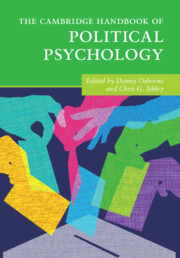Book contents
- The Cambridge Handbook of Political Psychology
- The Cambridge Handbook of Political Psychology
- Copyright page
- Dedication
- Contents
- Figures
- Tables
- Contributors
- Part I Foundations of Political Psychology
- 1 Political Psychology
- 2 The Evolutionary Basis of Political Ideology
- 3 Genetic Contributions to Political Phenomena
- 4 The Psychology and Neuroscience of Partisanship
- 5 The Personality Basis of Political Preferences
- 6 The Structure, Prevalence, and Nature of Mass Belief Systems
- 7 The Psychology of Public Opinion
- 8 Rational Choice and Information Processing
- 9 Emotions and Politics
- 10 The Developmental Science of Politics
- Part II The Politics of Intergroup Attitudes
- Part III Contemporary Challenges to Democracy
- Part IV Diversifying Perspectives in Political Psychology
- Index
- References
7 - The Psychology of Public Opinion
from Part I - Foundations of Political Psychology
Published online by Cambridge University Press: 17 February 2022
- The Cambridge Handbook of Political Psychology
- The Cambridge Handbook of Political Psychology
- Copyright page
- Dedication
- Contents
- Figures
- Tables
- Contributors
- Part I Foundations of Political Psychology
- 1 Political Psychology
- 2 The Evolutionary Basis of Political Ideology
- 3 Genetic Contributions to Political Phenomena
- 4 The Psychology and Neuroscience of Partisanship
- 5 The Personality Basis of Political Preferences
- 6 The Structure, Prevalence, and Nature of Mass Belief Systems
- 7 The Psychology of Public Opinion
- 8 Rational Choice and Information Processing
- 9 Emotions and Politics
- 10 The Developmental Science of Politics
- Part II The Politics of Intergroup Attitudes
- Part III Contemporary Challenges to Democracy
- Part IV Diversifying Perspectives in Political Psychology
- Index
- References
Summary
What is public opinion, what factors cause it to form in particular ways, and why does it matter? In this chapter, we define public opinion as opinions on matters of public debate that have significant implications for society. Then, we provide an overview of key developments in three central topics in research on public opinion. First, we discuss research on opinionation, or when and why a person forms an opinion on a political topic. Second, we discuss directionality of opinion, or factors that shape whether a person forms a particular kind of opinion (e.g., favourable or unfavourable) on an issue. Finally, we discuss the consequences of public opinion, or how opinions shape action, with a focus how public opinion influences voting, civic activism, and government attention and action. We end by considering emerging research trends in the field of public opinion that can inspire future research on the topic.
- Type
- Chapter
- Information
- The Cambridge Handbook of Political Psychology , pp. 104 - 117Publisher: Cambridge University PressPrint publication year: 2022



